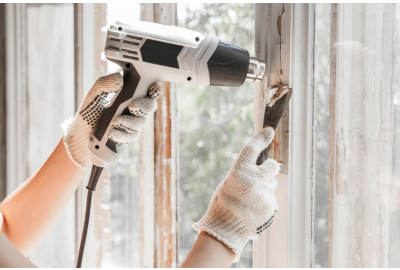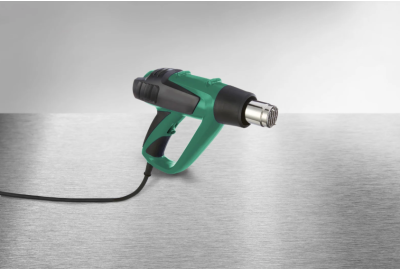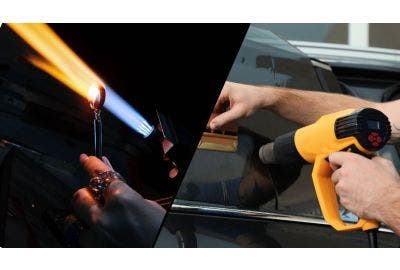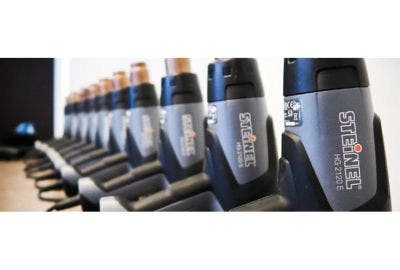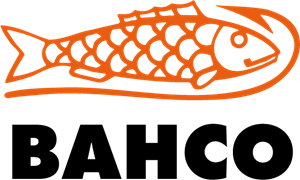Heat guns, though often overlooked, turn out to be far more useful than many people assume. They’re not just for trade professionals; DIYers too, find that once they’ve used one, it quickly becomes a bit of a go-to. From shifting stubborn wallpaper to reshaping plastic piping, these compact tools open up options across a whole range of jobs.
This guide outlines nine genuinely useful ways you might use a heat gun – and where you might want to be a little more cautious. You’ll find clear tips on getting the job done safely, efficiently, and with the right prep.
1. Paint Stripping
Old paint doesn’t always come off without a fight. That’s where heat guns comes in handy. By warming up the surface just enough to soften the layers, you’ll find that scraping becomes quicker and cleaner. Just keep the nozzle a few centimetres away – close enough to blister the paint, not scorch the surface underneath.
For best results:
- Work in sections
- Move the gun steadily to avoid hot spots
- Use a flat scraper once the paint bubbles up
Gloves and goggles aren’t optional–they’re the bare minimum for safe working here.
2. Vinyl Floor Removal
Peeling back vinyl flooring can be painstaking, but not if you apply heat first. That sticky adhesive underneath turns pliable under a steady blast, which means fewer tugs and less damage to your subfloor.
Start at one corner and lift slowly as you warm the patch ahead. It’s worth using a wide-blade scraper to keep the vinyl from tearing. Just take care not to overheat, especially near skirting boards.
3. Stripping Wallpaper
If you’ve wrestled with wallpaper steamers before, a heat gun might feel like a revelation. Instead of soaking everything, it targets only the area you're working on.
Direct the nozzle over the paper for a few seconds, then peel with a putty knife. It’s especially handy for removing old vinyl-backed wallpaper that resists traditional methods. Go slowly and keep checking the wall surface isn’t getting too hot.
4. Thawing Pipes
Frozen pipes can be more than inconvenient; they’re a potential plumbing disaster. A heat gun lets you warm them gently and gradually, unlike boiling water or open flames, which can cause cracks.
Hold the gun around 8 to 10 centimetres from the pipe and sweep slowly along the frozen section. Metal pipes respond well, though it’s best to steer clear of joints and plastic fittings. If you’re unsure, it’s better to consult a plumber first.
5. Drying Wood
Whether you're sealing timber or carrying out repairs, waiting for wood to dry naturally can test your patience. Heat guns help shift moisture evenly across the grain, speeding up the process without splitting the surface – so long as you don’t overdo it.
Set to a low temperature and keep the airflow moving. It’s not a fix for wet timber, but it’s perfect for drying treated wood or filler before sanding.
6. Wrapping Cars
Vehicle wraps are all about precision – and a heat gun helps you get there. It makes vinyl pliable enough to hug curves and edges, giving a clean finish without creases or bubbles.
Heat small sections as you go, smoothing out the material with a squeegee. If the wrap looks patchy or overstretched, pull it back slightly, reheat, and reset. Always wear gloves, and avoid working in windy spots where the wrap might shift or cool too fast.
7. Shrink Wrapping
Whether you're packing up tools or bundling wires, shrink wrap works best when paired with heat. The material shrinks tightly around the item, offering protection and keeping things compact.
Circle the heat gun around the item steadily and keep moving, lingering in one spot can cause melting. It’s a favourite trick in electronics, tool storage and even gift packaging.
8. Loosening Old Bolts
Stuck bolts often seem immovable until heat gets involved. By expanding the metal slightly, rust bonds loosen up, making it easier to turn the bolt with a wrench without shearing it off.
Target the bolt head with heat for around 20–30 seconds, then try your spanner. If it still won’t budge, apply penetrating oil once it cools down a bit, then try again. This method often avoids damage that brute force alone might cause.
9. Shaping PVC Pipes
Custom bends in PVC pipework aren’t just for pros. With a heat gun and a bit of care, anyone can get smooth, accurate shapes for plumbing or craft projects.
Warm the pipe gently and rotate it for an even temperature. Once it becomes flexible, use a guide or jig to bend it precisely. Let it cool naturally before handling, that way it sets faster and you’ll avoid warping.
When Not to Use a Heat Gun
Avoid using heat guns near flammable materials or in enclosed, poorly ventilated areas. Don’t use them as a substitute for hairdryers, because they reach temperatures that can burn skin or damage sensitive items. And steer clear of live wiring and always isolate electrical components first.
From professional-grade tasks like bolt removal to weekend projects involving car wraps or drying wood filler, heat guns really do earn their place. They’re precise, adaptable, and when used correctly, they are far safer than many assume.
At Heamar, we stock a wide range of heat guns, power tools and accessories to suit every budget and task. Whether you’re replacing an old one or picking up your first, we’ve got the right tools to help you get the job done with confidence.


